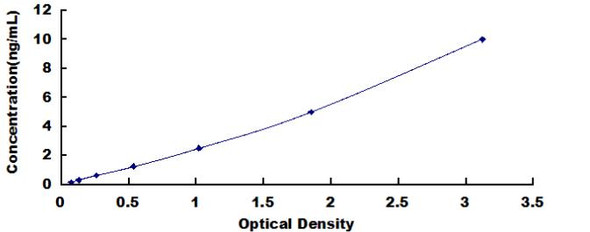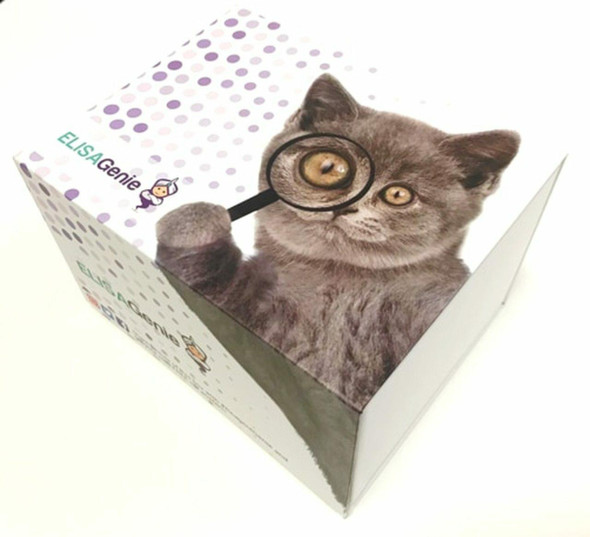Human SLC8A1 / Sodium / calcium exchanger 1 ELISA Kit
- SKU:
- HUFI00617
- Product Type:
- ELISA Kit
- Size:
- 96 Assays
- Uniprot:
- P32418
- Sensitivity:
- 0.094ng/ml
- Range:
- 0.156-10ng/ml
- ELISA Type:
- Sandwich
- Synonyms:
- SLC8A1, CNC, NCX1, Sodium, calcium exchanger 1, Solute carrier family 8 member 1
- Reactivity:
- Human
- Research Area:
- Signal Transduction
Description
Human SLC8A1/Sodium/calcium exchanger 1 ELISA Kit
The Human SLC8A1 (Sodium Calcium Exchanger 1) ELISA Kit is specifically designed for the precise measurement of SLC8A1 levels in human samples such as serum, plasma, and cell culture supernatants. This kit provides exceptional sensitivity and accuracy, ensuring the dependability and reproducibility of results for a variety of research purposes.SLC8A1, also known as the Sodium Calcium Exchanger 1, is a vital membrane protein responsible for the exchange of sodium and calcium ions in cells. This protein plays a critical role in cell signaling, muscle contraction, and neuronal function.
Dysregulation of SLC8A1 has been implicated in numerous diseases, including cardiovascular disorders, neurological conditions, and metabolic syndromes.By utilizing the Human SLC8A1 ELISA Kit, researchers can effectively measure SLC8A1 levels in biological samples, allowing for a better understanding of its role in disease pathogenesis and potential therapeutic interventions. This kit provides a valuable tool for studying the mechanisms underlying SLC8A1-related disorders and developing targeted treatments for improved patient outcomes.
| Product Name: | Human SLC8A1 / Sodium / calcium exchanger 1 ELISA Kit |
| Product Code: | HUFI00617 |
| Size: | 96 Assays |
| Alias: | SLC8A1, CNC, NCX1, Sodium, calcium exchanger 1, Solute carrier family 8 member 1 |
| Detection method: | Sandwich ELISA, Double Antibody |
| Application: | This immunoassay kit allows for the in vitro quantitative determination of Human SLC8A1 concentrations in serum plasma and other biological fluids. |
| Sensitivity: | 0.094ng/ml |
| Range: | 0.156-10ng/ml |
| Storage: | 4°C for 6 months |
| Note: | For Research Use Only |
| Recovery: | Matrices listed below were spiked with certain level of Human SLC8A1 and the recovery rates were calculated by comparing the measured value to the expected amount of Human SLC8A1 in samples. | ||||||||||||||||
| |||||||||||||||||
| Linearity: | The linearity of the kit was assayed by testing samples spiked with appropriate concentration of Human SLC8A1 and their serial dilutions. The results were demonstrated by the percentage of calculated concentration to the expected. | ||||||||||||||||
| |||||||||||||||||
| CV(%): | Intra-Assay: CV<8% Inter-Assay: CV<10% |
| Component | Quantity | Storage |
| ELISA Microplate (Dismountable) | 8×12 strips | 4°C for 6 months |
| Lyophilized Standard | 2 | 4°C/-20°C |
| Sample/Standard Dilution Buffer | 20ml | 4°C |
| Biotin-labeled Antibody(Concentrated) | 120ul | 4°C (Protect from light) |
| Antibody Dilution Buffer | 10ml | 4°C |
| HRP-Streptavidin Conjugate(SABC) | 120ul | 4°C (Protect from light) |
| SABC Dilution Buffer | 10ml | 4°C |
| TMB Substrate | 10ml | 4°C (Protect from light) |
| Stop Solution | 10ml | 4°C |
| Wash Buffer(25X) | 30ml | 4°C |
| Plate Sealer | 5 | - |
Other materials and equipment required:
- Microplate reader with 450 nm wavelength filter
- Multichannel Pipette, Pipette, microcentrifuge tubes and disposable pipette tips
- Incubator
- Deionized or distilled water
- Absorbent paper
- Buffer resevoir
| Uniprot | P32418 |
| UniProt Protein Function: | NCX1: Rapidly transports Ca(2+) during excitation-contraction coupling. Ca(2+) is extruded from the cell during relaxation so as to prevent overloading of intracellular stores. Belongs to the sodium/potassium/calcium exchanger family. SLC8 subfamily. 4 isoforms of the human protein are produced by alternative splicing. |
| UniProt Protein Details: | Protein type:Motility/polarity/chemotaxis; Membrane protein, multi-pass; Transporter, SLC family; Membrane protein, integral; Transporter Chromosomal Location of Human Ortholog: 2p22.1 Cellular Component: integral to plasma membrane; plasma membrane; sarcolemma; T-tubule; Z disc Molecular Function:ankyrin binding; calcium ion binding; calcium:sodium antiporter activity; cytoskeletal protein binding; protein binding Biological Process: calcium ion homeostasis; cardiac muscle cell development; cardiac muscle contraction; cellular sodium ion homeostasis; ion transport; muscle contraction; positive regulation of bone mineralization; reduction of cytosolic calcium ion concentration; regulation of heart rate; regulation of the force of heart contraction; vascular smooth muscle contraction |
| NCBI Summary: | In cardiac myocytes, Ca(2+) concentrations alternate between high levels during contraction and low levels during relaxation. The increase in Ca(2+) concentration during contraction is primarily due to release of Ca(2+) from intracellular stores. However, some Ca(2+) also enters the cell through the sarcolemma (plasma membrane). During relaxation, Ca(2+) is sequestered within the intracellular stores. To prevent overloading of intracellular stores, the Ca(2+) that entered across the sarcolemma must be extruded from the cell. The Na(+)-Ca(2+) exchanger is the primary mechanism by which the Ca(2+) is extruded from the cell during relaxation. In the heart, the exchanger may play a key role in digitalis action. The exchanger is the dominant mechanism in returning the cardiac myocyte to its resting state following excitation.[supplied by OMIM, Apr 2004] |
| UniProt Code: | P32418 |
| NCBI GenInfo Identifier: | 12644210 |
| NCBI Gene ID: | 6546 |
| NCBI Accession: | P32418.3 |
| UniProt Secondary Accession: | P32418,O95849, Q4QQG6, Q587I6, Q59GN4, Q9UBL8, Q9UD55 Q9UDN1, Q9UDN2, Q9UKX6, A8K6N1, D6W595, |
| UniProt Related Accession: | P32418 |
| Molecular Weight: | 107,938 Da |
| NCBI Full Name: | Sodium/calcium exchanger 1 |
| NCBI Synonym Full Names: | solute carrier family 8 member A1 |
| NCBI Official Symbol: | SLC8A1 |
| NCBI Official Synonym Symbols: | NCX1 |
| NCBI Protein Information: | sodium/calcium exchanger 1 |
| UniProt Protein Name: | Sodium/calcium exchanger 1 |
| UniProt Synonym Protein Names: | Na(+)/Ca(2+)-exchange protein 1; Solute carrier family 8 member 1 |
| Protein Family: | Sodium/calcium exchanger |
| UniProt Gene Name: | SLC8A1 |
| UniProt Entry Name: | NAC1_HUMAN |
*Note: Protocols are specific to each batch/lot. For the correct instructions please follow the protocol included in your kit.
Before adding to wells, equilibrate the SABC working solution and TMB substrate for at least 30 min at 37°C. When diluting samples and reagents, they must be mixed completely and evenly. It is recommended to plot a standard curve for each test.
| Step | Protocol |
| 1. | Set standard, test sample and control (zero) wells on the pre-coated plate respectively, and then, record their positions. It is recommended to measure each standard and sample in duplicate. Wash plate 2 times before adding standard, sample and control (zero) wells! |
| 2. | Aliquot 0.1ml standard solutions into the standard wells. |
| 3. | Add 0.1 ml of Sample / Standard dilution buffer into the control (zero) well. |
| 4. | Add 0.1 ml of properly diluted sample ( Human serum, plasma, tissue homogenates and other biological fluids.) into test sample wells. |
| 5. | Seal the plate with a cover and incubate at 37 °C for 90 min. |
| 6. | Remove the cover and discard the plate content, clap the plate on the absorbent filter papers or other absorbent material. Do NOT let the wells completely dry at any time. Wash plate X2. |
| 7. | Add 0.1 ml of Biotin- detection antibody working solution into the above wells (standard, test sample & zero wells). Add the solution at the bottom of each well without touching the side wall. |
| 8. | Seal the plate with a cover and incubate at 37°C for 60 min. |
| 9. | Remove the cover, and wash plate 3 times with Wash buffer. Let wash buffer rest in wells for 1 min between each wash. |
| 10. | Add 0.1 ml of SABC working solution into each well, cover the plate and incubate at 37°C for 30 min. |
| 11. | Remove the cover and wash plate 5 times with Wash buffer, and each time let the wash buffer stay in the wells for 1-2 min. |
| 12. | Add 90 µl of TMB substrate into each well, cover the plate and incubate at 37°C in dark within 10-20 min. (Note: This incubation time is for reference use only, the optimal time should be determined by end user.) And the shades of blue can be seen in the first 3-4 wells (with most concentrated standard solutions), the other wells show no obvious color. |
| 13. | Add 50 µl of Stop solution into each well and mix thoroughly. The color changes into yellow immediately. |
| 14. | Read the O.D. absorbance at 450 nm in a microplate reader immediately after adding the stop solution. |
When carrying out an ELISA assay it is important to prepare your samples in order to achieve the best possible results. Below we have a list of procedures for the preparation of samples for different sample types.
| Sample Type | Protocol |
| Serum | If using serum separator tubes, allow samples to clot for 30 minutes at room temperature. Centrifuge for 10 minutes at 1,000x g. Collect the serum fraction and assay promptly or aliquot and store the samples at -80°C. Avoid multiple freeze-thaw cycles. If serum separator tubes are not being used, allow samples to clot overnight at 2-8°C. Centrifuge for 10 minutes at 1,000x g. Remove serum and assay promptly or aliquot and store the samples at -80°C. Avoid multiple freeze-thaw cycles. |
| Plasma | Collect plasma using EDTA or heparin as an anticoagulant. Centrifuge samples at 4°C for 15 mins at 1000 × g within 30 mins of collection. Collect the plasma fraction and assay promptly or aliquot and store the samples at -80°C. Avoid multiple freeze-thaw cycles. Note: Over haemolysed samples are not suitable for use with this kit. |
| Urine & Cerebrospinal Fluid | Collect the urine (mid-stream) in a sterile container, centrifuge for 20 mins at 2000-3000 rpm. Remove supernatant and assay immediately. If any precipitation is detected, repeat the centrifugation step. A similar protocol can be used for cerebrospinal fluid. |
| Cell culture supernatant | Collect the cell culture media by pipette, followed by centrifugation at 4°C for 20 mins at 1500 rpm. Collect the clear supernatant and assay immediately. |
| Cell lysates | Solubilize cells in lysis buffer and allow to sit on ice for 30 minutes. Centrifuge tubes at 14,000 x g for 5 minutes to remove insoluble material. Aliquot the supernatant into a new tube and discard the remaining whole cell extract. Quantify total protein concentration using a total protein assay. Assay immediately or aliquot and store at ≤ -20 °C. |
| Tissue homogenates | The preparation of tissue homogenates will vary depending upon tissue type. Rinse tissue with 1X PBS to remove excess blood & homogenize in 20ml of 1X PBS (including protease inhibitors) and store overnight at ≤ -20°C. Two freeze-thaw cycles are required to break the cell membranes. To further disrupt the cell membranes you can sonicate the samples. Centrifuge homogenates for 5 mins at 5000xg. Remove the supernatant and assay immediately or aliquot and store at -20°C or -80°C. |
| Tissue lysates | Rinse tissue with PBS, cut into 1-2 mm pieces, and homogenize with a tissue homogenizer in PBS. Add an equal volume of RIPA buffer containing protease inhibitors and lyse tissues at room temperature for 30 minutes with gentle agitation. Centrifuge to remove debris. Quantify total protein concentration using a total protein assay. Assay immediately or aliquot and store at ≤ -20 °C. |
| Breast Milk | Collect milk samples and centrifuge at 10,000 x g for 60 min at 4°C. Aliquot the supernatant and assay. For long term use, store samples at -80°C. Minimize freeze/thaw cycles. |










